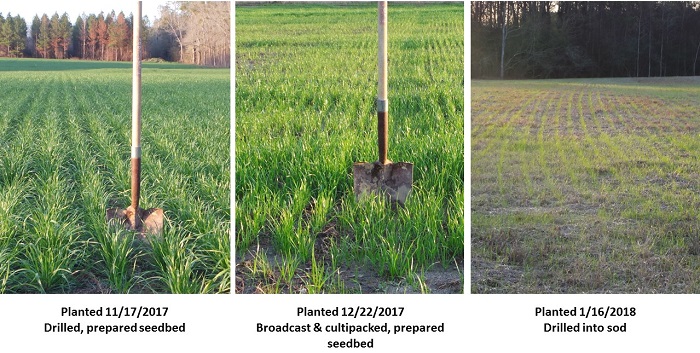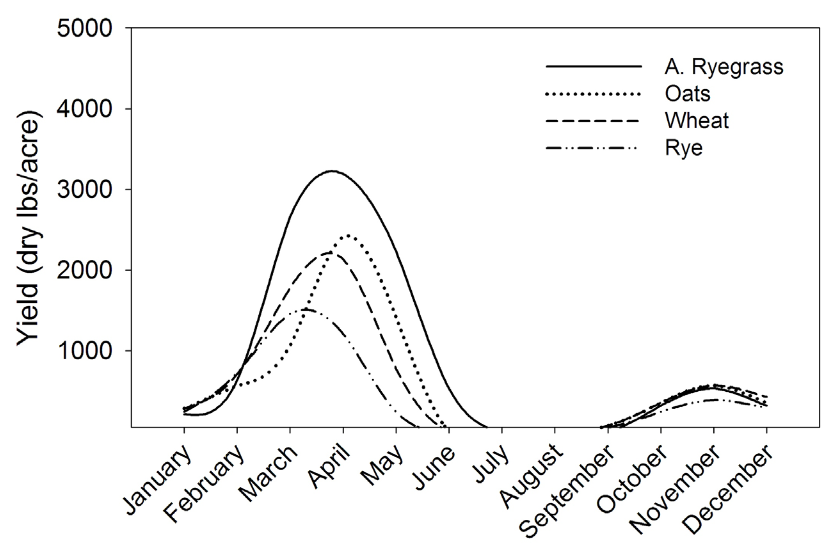
Cows gathered around a hay feeder in Washington County. This has been an all too common scene this winter while cattle and cattlemen alike wait on cool-season forages, which have gotten off to a slow and rocky start this year. Photo credit: Mark Mauldin
Cool-season annuals (ryegrass, small grains, clovers, etc.) are a vital part of our forage systems here in Northwest Florida and throughout the Southeast. Generally speaking, cool-season annuals are the highest quality forage we are able to produce. The significance of these forages is evidenced by the fact that many producers time their calving seasons so that the herd’s period of peak nutritional demand coincides with the peak production period of cool-season forages.
A tough season for cool-season forages
The recommended fall planting window (October 1 – November 15) was abnormally dry, forcing most producers to plant later than recommended. Later plantings force seedlings to emerge to colder temperatures (soil and air) and shorter days, with fewer hours of sunlight each day. Both of these factors cause forages to get off to very slow starts. Even ambitious producers that planted early, before the drought set in, faced significant challenges. Worst-case scenario, early plantings germinated and then died during the prolonged dry period. Best-case scenario, plant growth was so limited by dry conditions that expected plant performance advantages associated with timely planting have only recently become noticeable.
To further compound the situation, when the rain finally came, cold conditions (brutally cold by Florida standards) came with it. Keep in mind, the forages in question are referred to as “cool-season” not “cold-season.” While we generally are not concerned about Florida winter temperatures killing these plants, truly cold conditions can damage them, and will certainly prevent them from peak performance. In other words, forages that got off to a slow start from limited moisture were further delayed by the extended cold weather this year.

As growing conditions have improved in recent weeks the significance of planting date has become more evident in this Washington County ryegrass. These images were taken on 2/15/18, all within 10 minutes and 100 yds. of each other. None of these fields have been grazed. Photo credit : Mark Mauldin
Finally, growing conditions have improved considerably recently. Moisture has been adequate, even excessive this past week, and temperatures have warmed considerably. These factors combined with the lengthening days have really kicked forages into gear.
Key Forage Management Considerations
- Be patient; don’t graze your forages too soon. Let forages accumulate adequate leaf area/height before grazing. Ryegrass and small grains need have 8 to 12 inches of growth before grazing.
- Don’t graze forages too close. Removing all or nearly all leaf area greatly reduces the plants’ ability to regrow after grazing. The more leaf area left the faster the plants will regrow. The concept of “Take Half, Leave Half” is good to keep in mind when determining grazing height. Never graze ryegrass or small grains shorter than 3 inches, if regrowth if desired.
- Maximize forage utilization by implementing some form of controlled grazing. When cattle are allowed continuous access to forages, they will graze preferentially and trample more forage. When access is restricted by space, time, or both, cattle will graze more efficiently and forage utilization will increase.
- Allocate forages strategically. Cool-season annuals have a very high nutritional value. When they are in short supply, reserve them for animals that have the highest nutritional demands; lactating females and/or growing animals. This practice can greatly increase the value cool-season annuals bring to your operation, but it requires the ability and willingness to sort and manage cattle in different groups.
- Don’t forget about soil fertility. Maintaining adequate soil fertility will bolster plant performance. In many cases the performance of under fertilized forages will not be sufficient to warrant the initial establishment cost. Additionally, stressors, like nutrient deficiencies, can prompt annuals to forgo vegetative growth for reproductive growth, and set seed earlier than they otherwise would have.
- Maximize the growing season of annual forages. When annual plants make seed they stop vegetative growth. If conditions remain favorable and forages are able to “get ahead of the cows” be prepared to adjust stocking rates and/or controlled grazing practices to delay seed production for as long as possible, by allowing cattle to keep forages “toped-off”. As we get later into the spring, consider stockpiling forages planted on prepared ground and grazing over-seeded forages harder to prevent damage to the underlying perennial forages as they break dormancy.
[important]I understand. You’re tired of feeding so much hay, you’re past ready to turn out onto some grazing, your cows are tearing through the fence to get to something green, but that doesn’t mean you can throw open the gate and walk away. Years with poor growing conditions call for better management than years when conditions are optimal. The financial investment associated with establishing forages is the same regardless of the production; do what you can to maximize your return on investment.[/important]

Distribution of cool-season forage growth during a “normal” year. We are just entering the major growth period for the majority of our cool-season forages. Don’t give up on management; take full advantage of the remainder of the growing season. Image from: Forage Systems for Stocker Cattle, UGA Extension Bulletin 1392.
We don’t know how long growing conditions will remain favorable. Take steps now to ensure that your cool-season forages are able to bring as much value to your operation as possible. Even if it seems like your forages are really under-performing this year, don’t give up on management. Well managed cool-season annuals still have several months of growth left. There is still time to produce a substantial amount of nutrition for your herd. The considerations listed above are general guidelines. Every operation has different challenges and opportunities. Consult with your county’s UF/IFAS Agriculture Agent for assistance implementing strategies that can help you get the most out of your cool-season forages, this year, and in the future.
- Peanut Maturity Update – 10/9/25 - October 10, 2025
- Fall Can be a Great Time for Vegetation Management - October 3, 2025
- Peanut Maturity Update – 9/25/25 Edition - September 26, 2025
